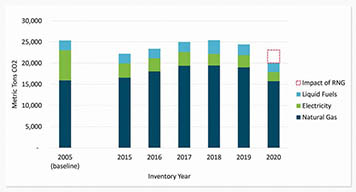
The Port of Seattle’s annual greenhouse gas emissions inventory, which was released Aug. 9, shows that it cut emissions from its own operations by 46% in 2021 as compared to the 2005 baseline.
The port’s Aviation division became the first major operating division to meet Seattle’s ambitious goal to reduce owned and controlled emissions by 50% by 2030. The massive reduction came almost entirely from the purchase of renewable natural gas produced from landfill waste, the port said.
The port has indicated that it expects to eliminate all carbon emissions from port-owned and controlled sources by 2040, and for all entities operating at its facilities to be carbon neutral or better by 2050.
“Renewable natural gas made this breakthrough possible,” Port Commissioner Ryan Calkins remarked. “The biggest challenge ahead of us remains the 99% of port-related emissions that come from our aviation, maritime and heavy transportation industry partners.”
The port has said that it’s continuing to pursue a transition to clean energy for owned and controlled emissions at the airport and seaport. Changes for the next decade include electrification/decarbonization of the airport’s central boiler system, more seaport shorepower solutions and a clean-energy strategy for the entire Seattle waterfront. Other steps include electrification of the port’s fleet vehicles and a ground transportation plan for the airport to incentivize low-carbon modes of travel to Seattle-Tacoma International Airport.
The port operations inventory measures emissions from port-owned and controlled sources like building facilities and vehicle fleets. This inventory does not include emissions from the entities that operate at port facilities, such as airlines and cruise lines. Port-owned and controlled emissions comprise less than 1% of all port-related emissions, according to the agency.
